Price Determinants and GIS Analysis of the Housing Market in Vietnam: The Cases of Ho Chi Minh City and Hanoi
Abstract
1. Introduction
1.1. The Growth of the Housing Market in Vietnam
1.2. Significance of Ho Chi Minh City (HCMC) and Hanoi in Vietnam
1.3. Differences between the Housing Market in HCMC and Hanoi
2. Literature Review
3. Research Methods
3.1. Data Collection and Geographic Information System (GIS) Setting
3.2. Hedonic Price Model
- p denotes the sales price of an apartment unit;
- is a vector of the random error terms;
- k (k = 1,…, K) is the coefficient matrix of independent variables X.
4. Analysis Results
4.1. GIS Analysis of Apartments Distribution in HCMC and Hanoi
4.2. Descriptive Statistics of Apartment Projects in HCMC and Hanoi
4.3. Regression Results with GIS Analysis
5. Discussion
6. Conclusions
Author Contributions
Funding
Conflicts of Interest
References
- Anwar, S.; Nguyen, L.P. Foreign direct investment and economic growth in Vietnam. Asia Pac. Bus. Rev. 2010, 16, 183–202. [Google Scholar] [CrossRef]
- Nguyen, V.Q. Vietnam’s New Land Law: The Impact on Foreign Developers; Tilleke&Gibbins: Bangkok, Thailand, 2014. [Google Scholar]
- Pham, T. The Revised Land Law Will Ensure More Transparent and Equitable Treatment for All Land Users; CBRE: Los Angeles, CA, USA, 2014. [Google Scholar]
- Nguyen, T.B.; van der Krabben, E.; Samsura, D.A.A. Commercial real estate investment in Ho Chi Minh City–a level playing field for foreign and domestic investors? Habitat Int. 2014, 44, 412–421. [Google Scholar] [CrossRef]
- Phe, H.H. Investment in residential property: Taxonomy of home improvers in central Hanoi. Habitat Int. 2002, 26, 471–486. [Google Scholar] [CrossRef]
- Huu Phe, H.; Wakely, P. Status, quality and the other trade-off: Towards a new theory of urban residential location. Urban Stud. 2000, 37, 7–35. [Google Scholar] [CrossRef]
- Cira, D. Vietnam Urbanization Review Technical Assistance Report; World Bank: Hanoi, Vietnam, 2011; p. 177. [Google Scholar]
- Surborg, B. Advanced services, the new economy and the built environment in Hanoi. Cities 2006, 23, 239–249. [Google Scholar] [CrossRef]
- Kim, A.M. North versus south: The impact of social norms in the market pricing of private property rights in Vietnam. World Dev. 2007, 35, 2079–2095. [Google Scholar] [CrossRef]
- Turley, W.S.; Womack, B. Asian socialism’s open doors: Guangzhou and Ho Chi Minh City. China J. 1998, 40, 95–119. [Google Scholar] [CrossRef]
- Cung, D.N.; Tuan, P.A.; Van, B.; Dapice, D. History or Policy: Why Don’t Northern Provinces Grow Faster; Harvard University: Cambridge, MA, USA, 2004. [Google Scholar]
- Cross, A.; Ryan, V.; Hoa, M.T.T. HCMC Hanoi Regional Consumer Differences; Nielsen: New York, NY, USA, 2009. [Google Scholar]
- Quang, N.; Kammeier, H.D. Changes in the political economy of Vietnam and their impacts on the built environment of Hanoi. Cities 2002, 19, 373–388. [Google Scholar] [CrossRef]
- Nguyen, T.N. Foreign direct investment in real estate projects and macroeconomic instability. ASEAN Econ. Bull. 2011, 28, 74–96. [Google Scholar] [CrossRef]
- CBRE. Vietnam Market Outlook. 2014. Available online: www.cbrevietnam.com (accessed on 7 July 2018).
- Kim, A.M. A market without the ‘right’ property rights. Econ. Transit. 2004, 12, 275–305. [Google Scholar] [CrossRef]
- Court, A.T. Hedonic price indexes with automotive examples. Dyn. Automob. Demand 1939. [Google Scholar]
- Lancaster, K.J. A new approach to consumer theory. J. Polit. Econ. 1966, 74, 132–157. [Google Scholar] [CrossRef]
- Rosen, S. Hedonic prices and implicit markets: Product differentiation in pure competition. J. Polit. Econ. 1974, 82, 34–55. [Google Scholar] [CrossRef]
- Massimo, D.E.; Del Giudice, V.; De Paola, P.; Forte, F.; Musolino, M.; Malerba, A. Geographically Weighted Regression for the Post Carbon City and Real Estate Market Analysis: A Case Study; International Symposium on New Metropolitan Perspectives; Springer: Berlin, Germany, 2018; pp. 142–149. [Google Scholar]
- Del Giudice, V.; De Paola, P. Spatial analysis of residential real estate rental market with geoadditive models. In Advances in Automated Valuation Modeling; Springer: Berlin, Germany, 2017; pp. 155–162. [Google Scholar]
- Kain, J.F.; Quigley, J.M. Measuring the value of housing quality. J. Am. Stat. Assoc. 1970, 65, 532–548. [Google Scholar] [CrossRef]
- Sirmans, G.S.; MacDonald, L.; Macpherson, D.A.; Zietz, E.N. The value of housing characteristics: A meta analysis. J. Real Estate Financ. Econ. 2006, 33, 215–240. [Google Scholar] [CrossRef]
- Kohlhase, J.E. The impact of toxic waste sites on housing values. J. Urban Econ. 1991, 30, 1–26. [Google Scholar] [CrossRef]
- Kilpatrick, J.A.; Hefner, F. House Price Impact of School District Choice; South Carolina Center for Applied Real Estate Education and Research: South Carolina, USA, 1998. [Google Scholar]
- Gibbons, S.; Machin, S. Valuing English primary schools. J. Urban Econ. 2003, 53, 197–219. [Google Scholar] [CrossRef]
- Visser, P.; Van Dam, F.; Hooimeijer, P. Residential environment and spatial variation in house prices in the Netherlands. Tijdschr. Econ. Soc. Geogr. 2008, 99, 348–360. [Google Scholar] [CrossRef]
- Baumont, C.; Legros, D. Neighborhood Effects in Spatial Housing Value Models. The Case of the Metropolitan Area of Paris (1999); Federal Reserve Bank of St Louis: St Louis, MO, USA, 2009. [Google Scholar]
- Bateman, I.; Day, B.; Lake, I.; Lovett, A. The Effect of Road Traffic on Residential Property Values: A Literature Review and Hedonic Pricing Study; Scottish Executive: Edinburgh, UK, 2001; Volume 207. [Google Scholar]
- Day, B.; Bateman, I.; Lake, I. Beyond implicit prices: Recovering theoretically consistent and transferable values for noise avoidance from a hedonic property price model. Environ. Resour. Econ. 2007, 37, 211–232. [Google Scholar] [CrossRef]
- Nelson, J.P. Highway noise and property values: A survey of recent evidence. J. Transp. Econ. Policy 1982, 16, 117–138. [Google Scholar]
- Schipper, Y.; Nijkamp, P.; Rietveld, P. Why do aircraft noise value estimates differ? A meta-analysis. J. Air Transp. Manag. 1998, 4, 117–124. [Google Scholar] [CrossRef]
- Del Giudice, V.; De Paola, P.; Manganelli, B.; Forte, F. The monetary valuation of environmental externalities through the analysis of real estate prices. Sustainability 2017, 9, 229. [Google Scholar] [CrossRef]
- Anderson, R.J., Jr.; Crocker, T.D. Air pollution and residential property values. Urban Stud. 1971, 8, 171–180. [Google Scholar] [CrossRef]
- Murdoch, J.C.; Thayer, M.A. Hedonic price estimation of variable urban air quality. J. Environ. Econ. Manag. 1988, 15, 143–146. [Google Scholar] [CrossRef]
- Graves, P.; Murdoch, J.C.; Thayer, M.A.; Waldman, D. The robustness of hedonic price estimation: Urban air quality. Land Econ. 1988, 64, 220–233. [Google Scholar] [CrossRef]
- Smith, V.K.; Huang, J.C. Can markets value air quality? A meta-analysis of hedonic property value models. J. Polit. Econ. 1995, 103, 209–227. [Google Scholar] [CrossRef]
- Michael, H.J.; Boyle, K.J.; Bouchard, R. Water Quality Affects Property Prices: A Case Study of Selected Maine Lakes; Maine Agricultural and Forest Experiment Station Report Number 398; University of Maine: Orono, ME, USA, 1996. [Google Scholar]
- Steinnes, D.N. Measuring the economic value of water quality. Ann. Reg. Sci. 1992, 26, 171–176. [Google Scholar] [CrossRef]
- Wilman, E.A.; Krutilla, J. Hedonic prices and beach recreational values. Adv. Appl. Microeconomics 1981, 1, 98. [Google Scholar]
- Anderson, S.T.; West, S.E. Open space, residential property values, and spatial context. Reg. Sci. Urban Econ. 2006, 36, 773–789. [Google Scholar] [CrossRef]
- Lutzenhiser, M.; Netusil, N.R. The effect of open spaces on a home’s sale price. Contemp. Econ. Policy 2001, 19, 291–298. [Google Scholar] [CrossRef]
- Nowak, D.J.; McPherson, E.G. Quantifying the impact of trees: The Chicago urban forest climate project. Unasylva 1993, 173, 39–44. [Google Scholar]
- Tyrväinen, L. The amenity value of the urban forest: An application of the hedonic pricing method. Landsc. Urban Plan. 1997, 37, 211–222. [Google Scholar] [CrossRef]
- Heikkila, E.; Gordon, P.; Kim, J.I.; Peiser, R.B.; Richardson, H.W.; Dale-Johnson, D. What happened to the cbd-distance gradient?: Land values in a policentric city. Environ. Plan. A 1989, 21, 221–232. [Google Scholar] [CrossRef]
- Seo, D.; Chung, Y.S.; Kwon, Y. Price determinants of affordable apartments in Vietnam: Toward the public–private partnerships for sustainable housing development. Sustainability 2018, 10, 197. [Google Scholar] [CrossRef]
- Landau, U.; Prashker, J.N.; Hirsh, M. The effect of temporal constraints on household travel behavior. Environ. Plan. A 1981, 13, 435–448. [Google Scholar] [CrossRef]
- Henneberry, J. Transport investment and house prices. J. Prop. Valuation Investment 1998, 16, 144–158. [Google Scholar] [CrossRef]
- Hanushek, E.A.; Yilmaz, K. Household Location and Schools in Metropolitan Areas with Heterogeneous Suburbs; Tiebout, Alonso, and Government Policy; NBER Working Papers 15; National Bureau of Economic Research: Cambridge, MA, USA, 2010. [Google Scholar]
- Chung, Y.S.; Kim, J.H.; Cho, J.H. Analysis of price determinants of apartments in Ho Chi Minh. J. Korean Hous. Assoc. 2014, 12, 13–21. [Google Scholar]
- Huynh, D. Phu my hung new urban development in Ho Chi Minh City: Only a partial success of a broader landscape. Int. J. Sustain. Built Environ. 2015, 4, 125–135. [Google Scholar] [CrossRef]
- Kato, H.; Nguyen, L.H. Land policy and property price in Hanoi, Vietnam. J. East. Asia Soc. Transp. Stud. 2010, 8, 1011–1026. [Google Scholar]
- Thanh-Nien-News. Shocking Photos Reveal How Saigon Traffic Has Gone from Bad to Worse. Available online: http://www.thanhniennews.com/society/shocking-photos-reveal-how-saigon-traffic-has-gone-from-bad-to-worse-51386.html (accessed on 22 June 2018).
- Lan, T.T.N.; Liem, N.Q.; Binh, N.T.T. Personal exposure to benzene of selected population groups and impact of commuting modes in Ho Chi Minh, Vietnam. Environ. Pollut. 2013, 175, 56–63. [Google Scholar] [CrossRef] [PubMed]
- Le, T.P.L.; Trinh, T.A. Encouraging public transport use to reduce traffic congestion and air pollutant: A case study of Ho Chi Minh City, Vietnam. Procedia Eng. 2016, 142, 236–243. [Google Scholar] [CrossRef]
- Eckert, R.; Schinkel, U. Liveable City tp. Ho Chi Minh-Adaptation as Response to Impacts of Climate Change. REAL CORP. 2009, 313–323. [Google Scholar]
- Seo, D.; Kwon, Y. In-migration and housing choice in Ho Chi Minh City: Toward sustainable housing development in Vietnam. Sustainability 2017, 9, 1738. [Google Scholar] [CrossRef]
- Vietnamnet. More Traffic Jams in Hanoi as Personal Vehicles Increase. Available online: https://english.vietnamnet.vn/fms/society/141019/more-traffic-jams-in-hanoi-as-personal-vehicles-increase.html (accessed on 15 October 2018).
- UN Habitat. Vietnam Housing Sector Profile; UN Habitat: Nairobi, Kenya, 2014; p. 158. [Google Scholar]
- UN Habitat. Mapping Urban Poverty in Ho Chi Minh City; UN Habitat: Hanoi Vietnam, 2008; p. 81. [Google Scholar]
- Tuoitrenews. Long-Lasting Troubles of Living in Apartments in Vietnam. Available online: http://tuoitrenews.vn/features/26584/longlasting-troubles-of-living-in-apartments-in-vietnam (accessed on 15 April 2018).
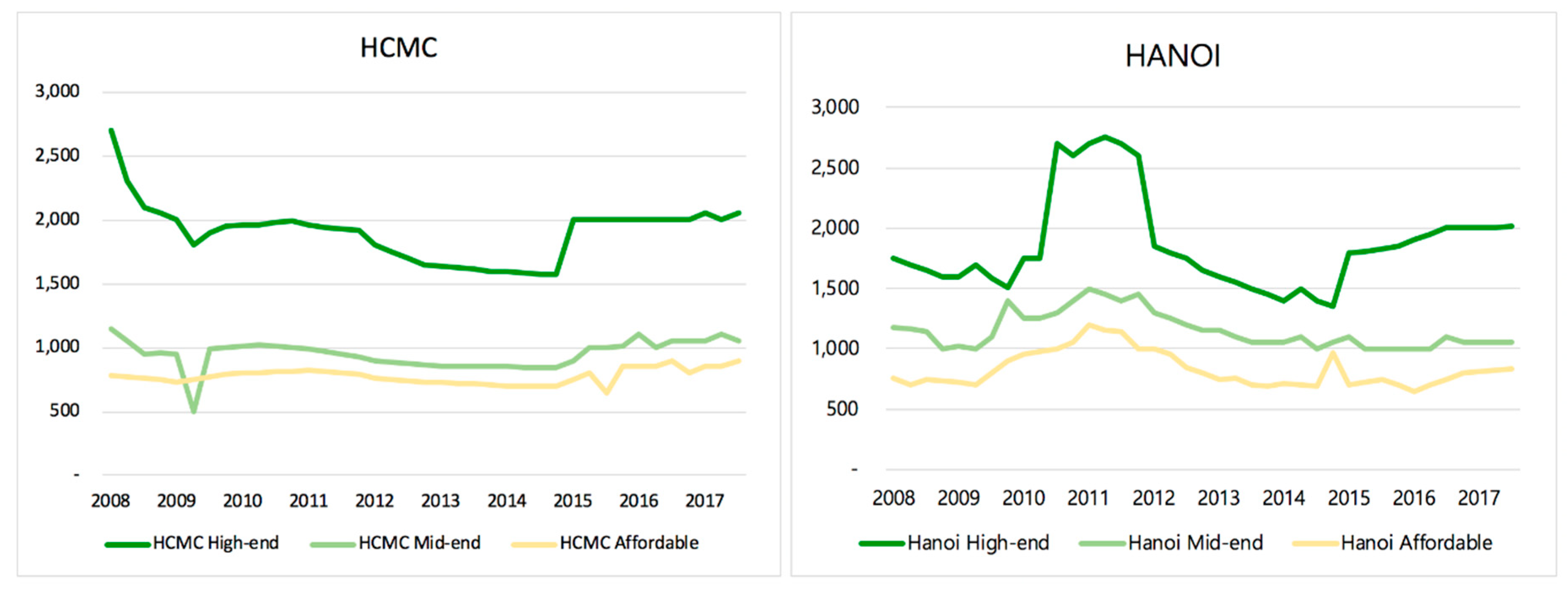
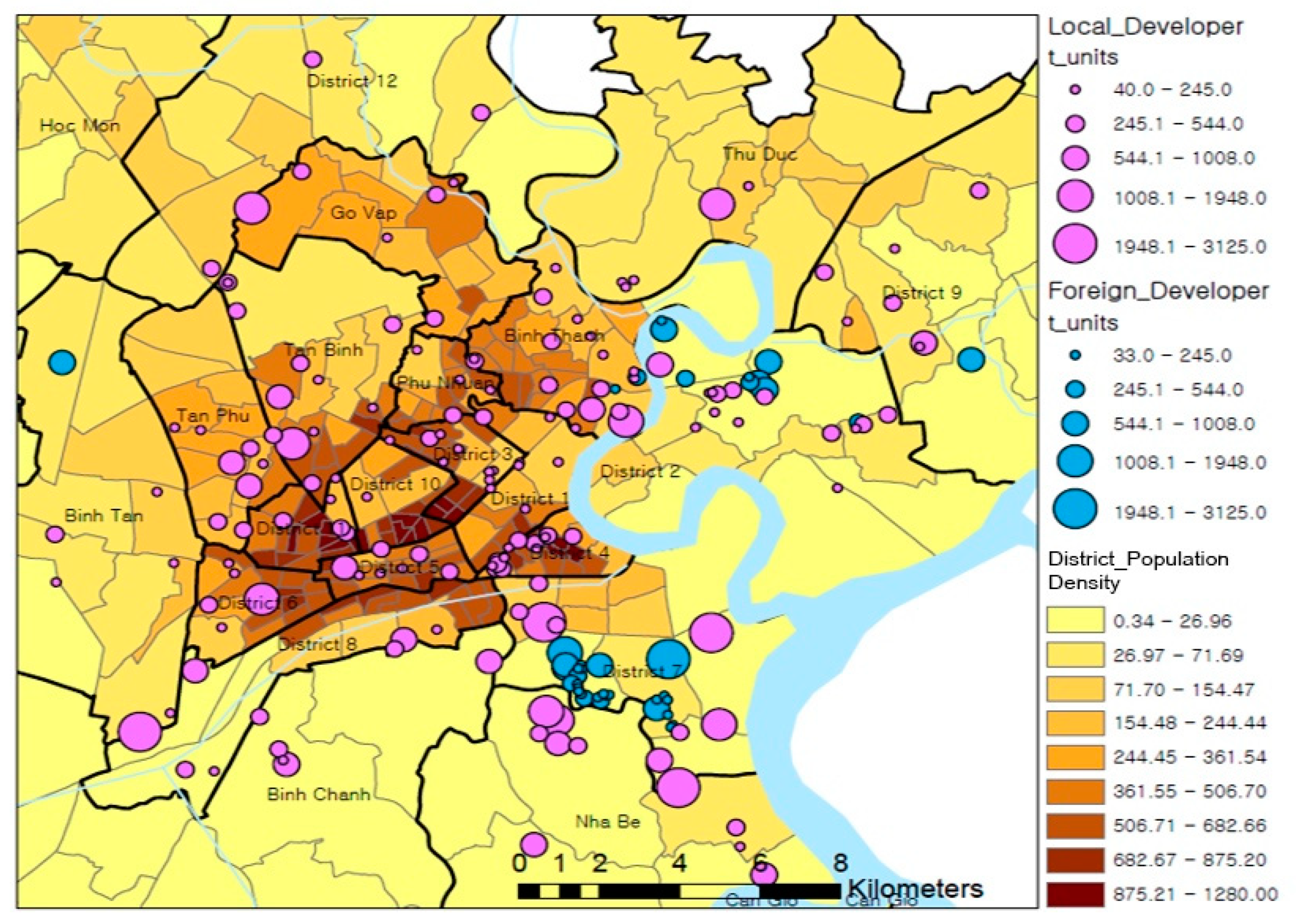
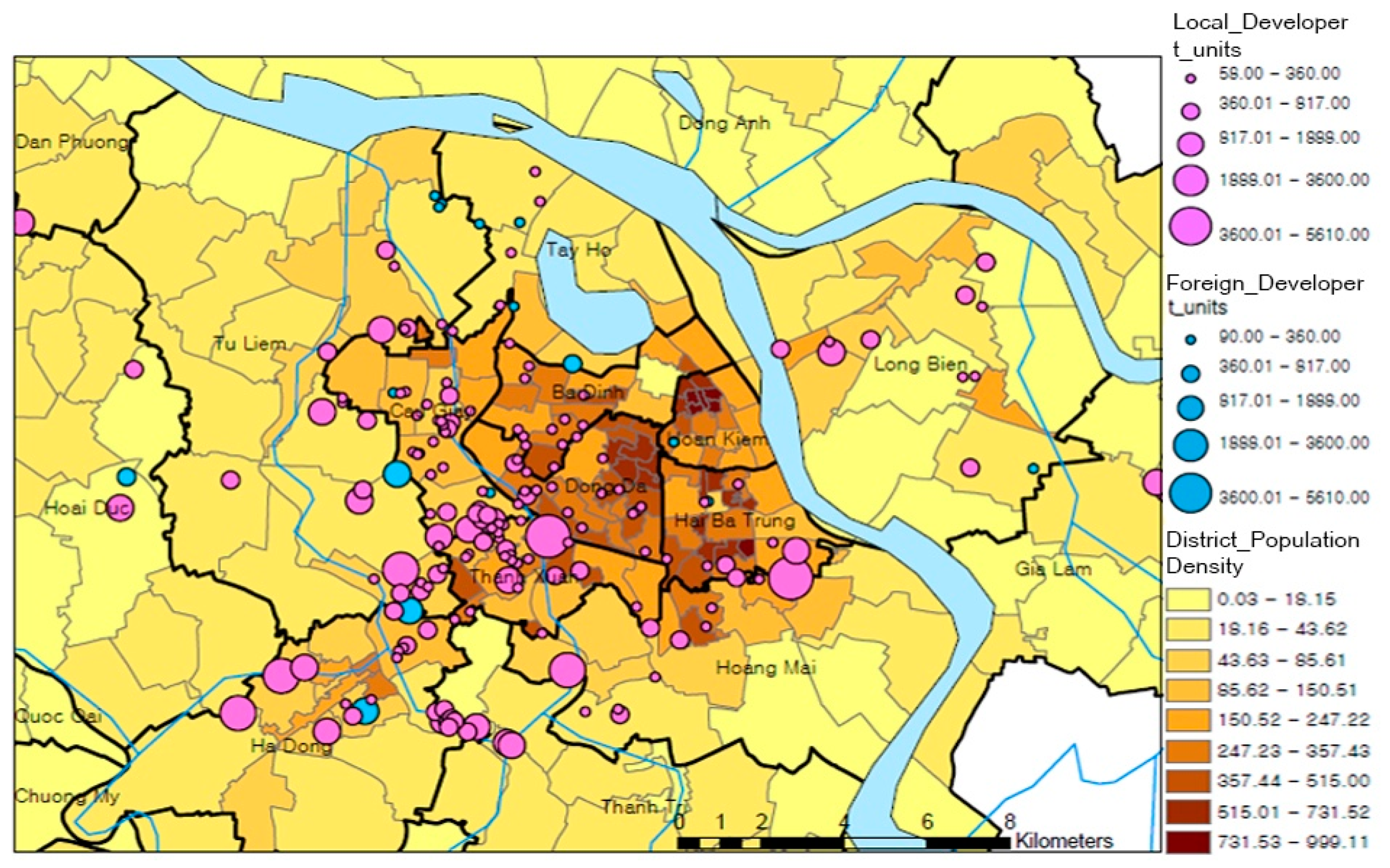
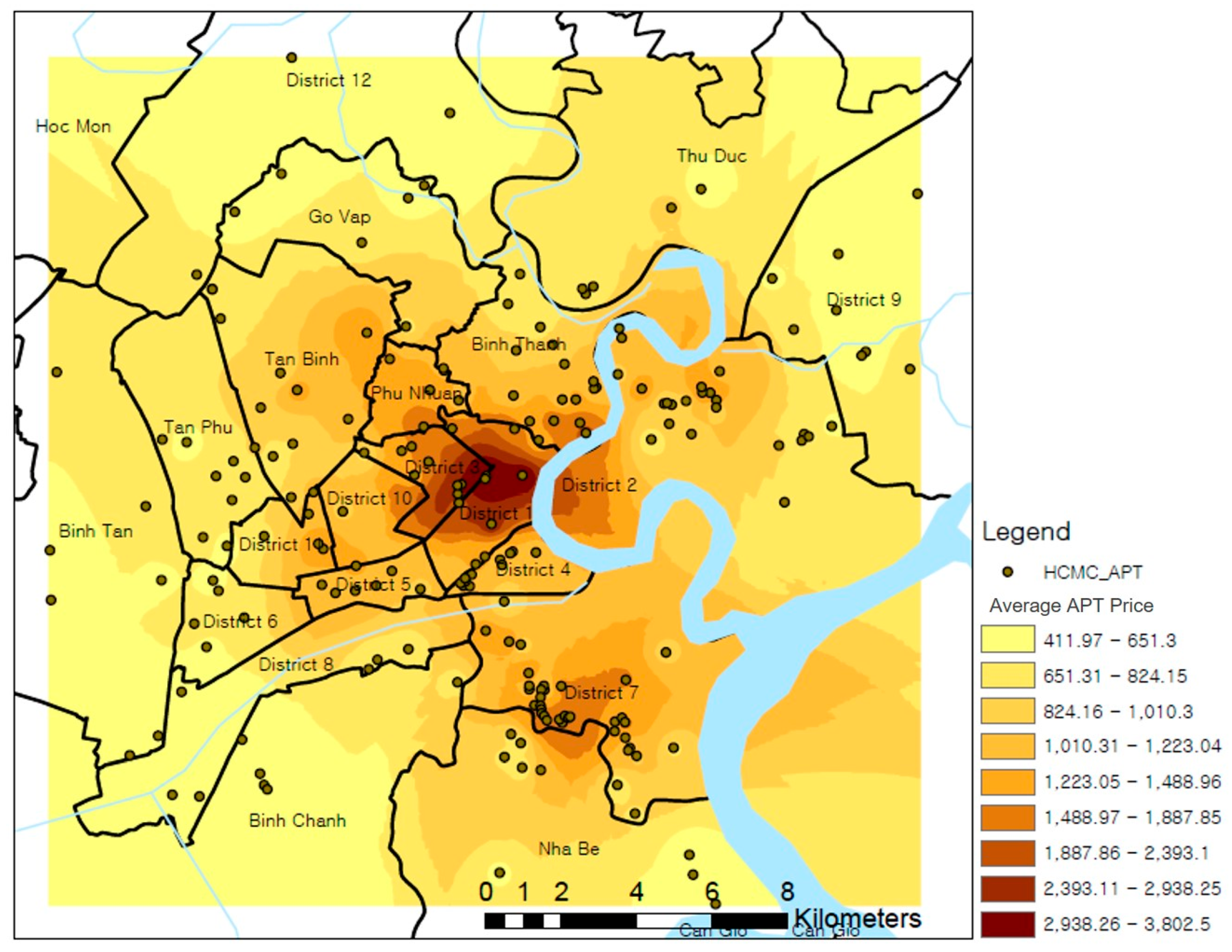
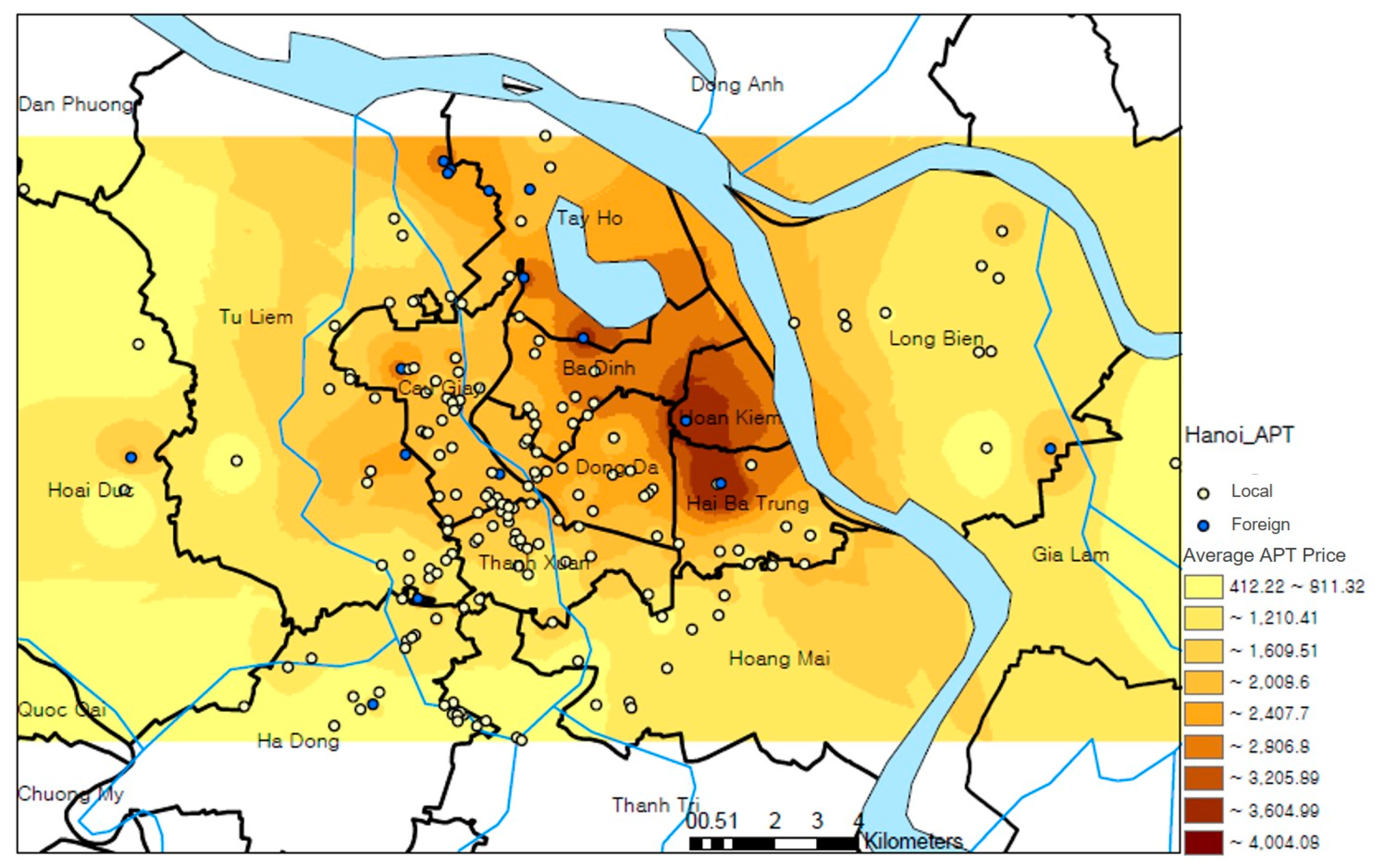
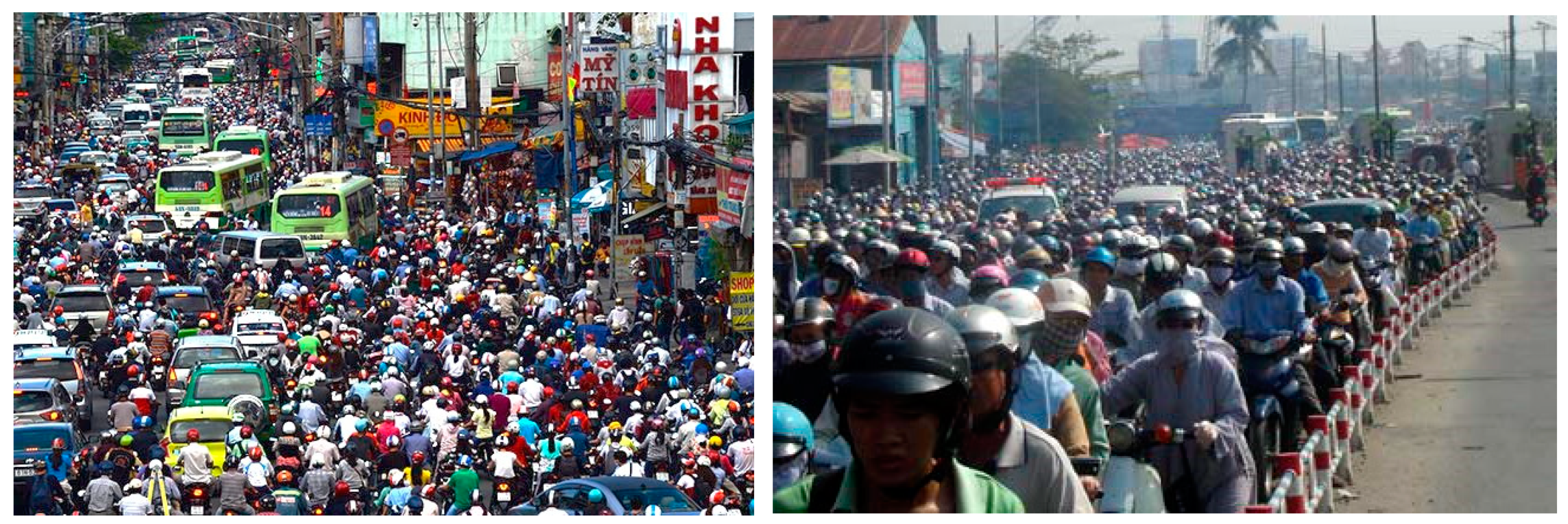
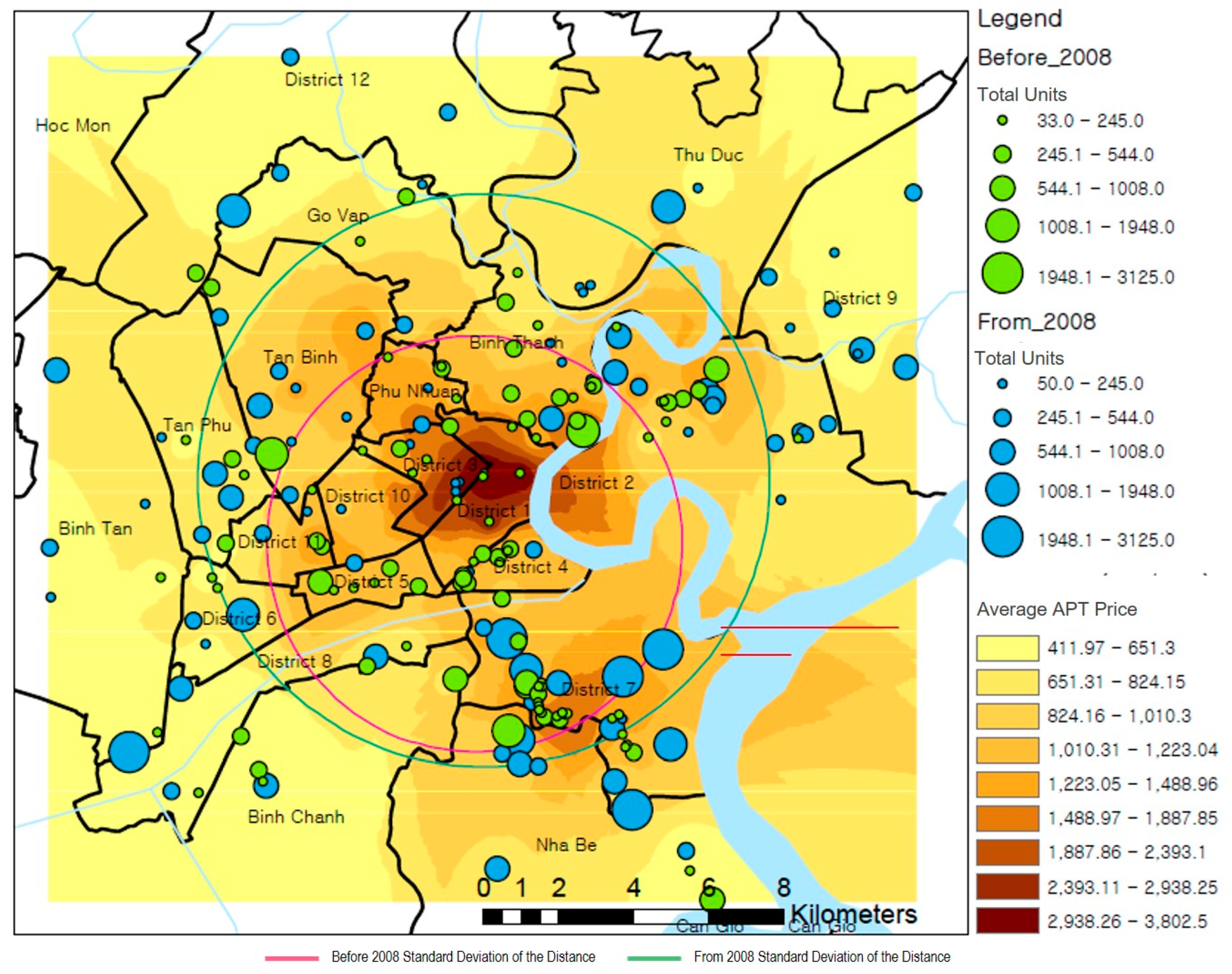
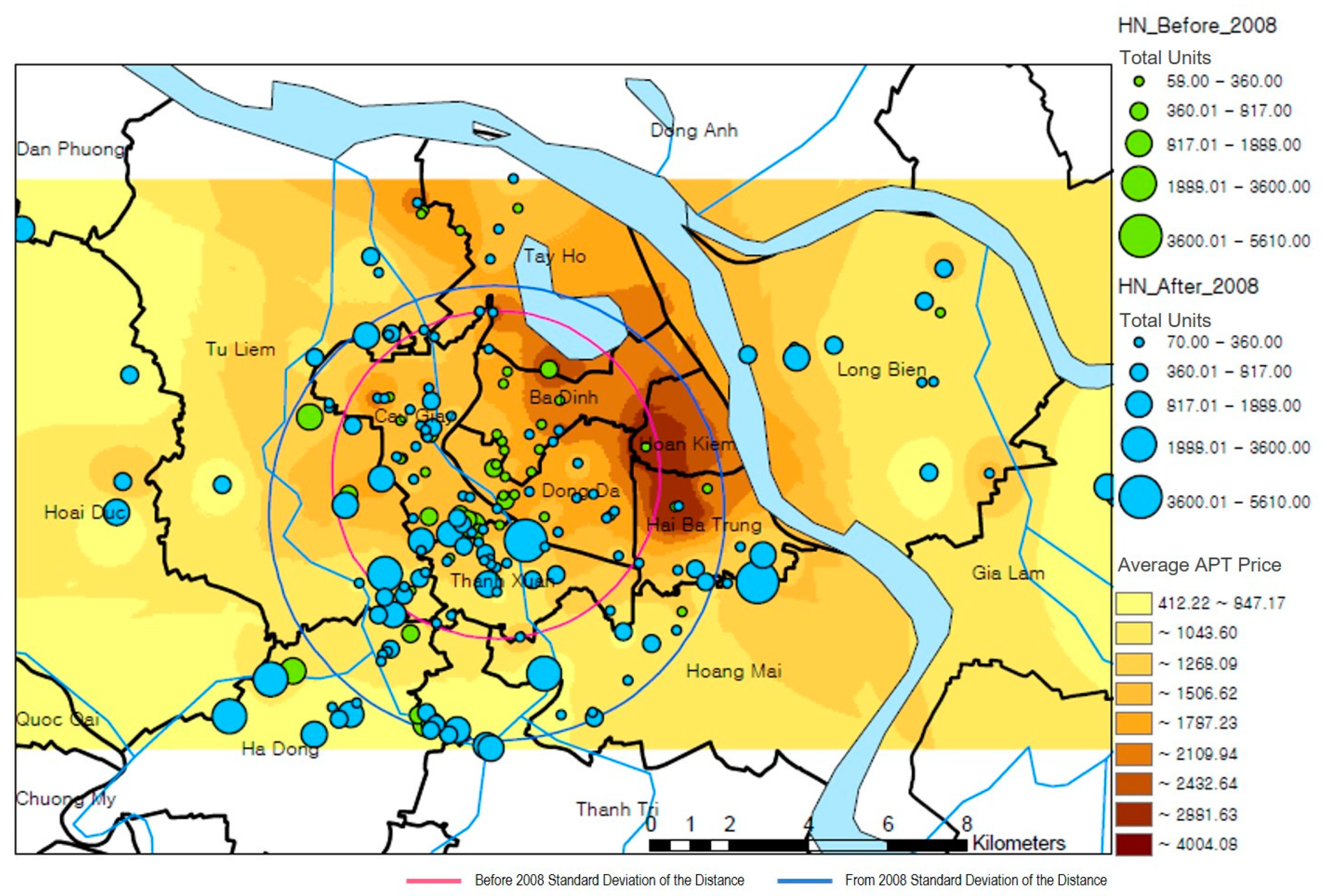
| Unit | Hanoi | HCMC | Vietnam | |
|---|---|---|---|---|
| Population | 7,587,800 (8%) | 8,444,600 (9%) | 94,569,072 | |
| Density | Population/km2 | 2300 | 4097 | 276 |
| Area (municipality) | km2 | 3329 | 2061 | 331,212 |
| Area (metropolitan) | km2 | 24,314.70 | 10,619.40 | |
| GDP (total) | USD. Billion | 31.20 (12.9%) | 53.83 (22.4%) | 240.78 |
| GDP (per capita) | USD | 4031 | 6389 | 2546 |
| FDI | USD. Million | 27,638 (8.6%) | 43,879 (13.7%) | 319,613 |
| Year | HCMC | Hanoi | ||
|---|---|---|---|---|
| Expenditure | Apartment Supply | Expenditure | Apartment Supply | |
| 2008 | 42,091 | 9500 | 38,320 | 5200 |
| 2009 | 50,950 (21.0%) | 11,500 (21.1%) | 57,537 (50.1%) | 15,500 (198%) |
| 2010 | 56,944 (11.8%) | 19,500 (69.6%) | 72,622 (26.2%) | 15,000 (−3.2%) |
| 2011 | 64,745 (13.7%) | 9000 (−53.8%) | 81,689 (12.5%) | 23,000 (53.3%) |
| 2012 | 74,913 (15.7%) | 4000 (−55.6%) | 93,137 (14%) | 10,500 (−54.3%) |
| 2013 | 69,173 (−7.7%) | 8000 (100%) | 80,627 (−13.4%) | 11,500 (9.5%) |
| 2014 | 71,716 (3.7%) | 18,000 (125%) | 77,131 (−4.3%) | 17,500 (52.2%) |
| 2015 | 59,735 (−20.1%) | 41,000 (127.8%) | 111,678 (30.9%) | 34,000 (94.3%) |
| 2016 | 47,789 (−25%) | 38,000 (−7.3%) | 107,844 (−3.5%) | 35,000 (2.9%) |
| 2017 | 67,075 (28.8%) | 31,900 (−16.1%) | 75,205 (−43.4%) | 35,300 (0.86%) |
| Categories | Variables | Code | Unit | Description |
|---|---|---|---|---|
| Housing Attributes | Apartment price (Dependent) Average unit area Age of housing Highest floor | avg_price mdn_area p_year h_story | USD/m2 m2 year floor | Average sales price per m2 Apartment unit area Building age Number of building floors |
| Community Attributes | Population density of district Total number of households Pool Mixed-use development Development by foreign developers Natural ventilation Retail on ground level | pop_den t_units d_pool d_of_ds d_foreign d_air d_shop | person/ha unit dummy dummy dummy dummy dummy | District of apartment location Total number of apartment units Existence in the project Commercial/office/residential Foreign developer Natural air flow in public corridor Ground floor shops |
| Locational Attributes | Location in new town Location in downtown Adjacency to main road Distance to downtown Proximity to park Proximity to river Proximity to international school Proximity shopping mall | d_ncity d_center d_mroad cbd_m d_park d_river d_Is d_com | dummy dummy dummy m dummy dummy dummy dummy | Phu My Hung new town Districts 1, 3/Hoan Kiem, Hai BaTrung Over four lane road To the Presidential Palace in District 1 Formal urban parks Formal urban rivers Primary and secondary schools Corporate shopping malls |
| Variables | HCMC (n = 197) | Hanoi (n = 187) | |||
|---|---|---|---|---|---|
| Description | Code | Mean | S.D. | Mean | S.D. |
| Apartment price (USD/m2) | avg_price | 1074 | 587 | 1234 | 469 |
| Population density of district | pop_den | 209 | 251 | 140 | 125 |
| Total number of households | t_units | 415 | 483 | 512 | 687 |
| Age of housing | p_year | 4.47 | 3.23 | 3.40 | 3.12 |
| Highest floor | h_story | 17.7 | 6.99 | 23.1 | 7.87 |
| Average unit area | mdn_area | 96.9 | 26.9 | 103 | 24.9 |
| Development by foreign developers | d_foreign | 0.20 | 0.40 | 0.09 | 0.28 |
| Location downtown | d_center | 0.09 | 0.28 | 0.02 | 0.15 |
| Location in new town | d_ncity | 0.18 | 0.39 | - | - |
| Pool | d_pool | 0.48 | 0.50 | 0.28 | 0.45 |
| Mixed-use development | d_of_ds | 0.05 | 0.21 | 0.07 | 0.26 |
| Retail on ground level | d_shop | 0.08 | 0.27 | 0.26 | 0.44 |
| Adjacency to the main road | d_mroad | 0.41 | 0.49 | 0.60 | 0.49 |
| Proximity to park | d_park | 0.20 | 0.40 | 0.44 | 0.50 |
| Proximity to river | d_river | 0.19 | 0.40 | 0.18 | 0.38 |
| Proximity to international school | d_Is | 0.16 | 0.37 | 0.40 | 0.49 |
| Proximity shopping mall | d_com | 0.33 | 0.47 | 0.46 | 0.50 |
| Distance to downtown | cbd_m | 5957 | 2892 | 6015 | 2546 |
| Natural ventilation | d_air | 0.37 | 0.48 | 0.78 | 0.42 |
| Independent Variable | HCMC | Hanoi | |
|---|---|---|---|
| Population density of district | pop_den | −0.096 (−2.140) ** | 0.019 (0.435) |
| Total number of households | t_units | −0.028 (−0.531) | 0.028 (0.658) |
| Age of housing | p_year | −0.120 (−2.514) ** | 0.132 (3.148) ** |
| Highest floor | h_story | −0.104 (−1.797) | 0.036 (0.750) |
| Average unit area | mdn_area | 0.103 (2.082) | 0.101 (2.356) * |
| Development by foreign developers | d_foreign | 0.055 (0.943) | 0.297 (6.984)** |
| Location in downtown | d_center | 0.327 (7.242) ** | 0.345 (8.510) ** |
| Location in new town | d_ncity | 0.045 (0.818) | − |
| Pool | d_pool | 0.196 (3.943) ** | 0.071 (1.541) * |
| Mixed-use development | d_of_ds | 0.222 (5.227) ** | 0.069 (1.716) |
| Retail on ground level | d_shop | −0.014 (−0.348) | −0.035 (−0.853) * |
| Adjacency to the main road | d_mroad | 0.035 (0.834) | 0.032 (0.772) |
| Proximity to park | d_park | 0.121 (2.987) ** | 0.068 (1.780) |
| Proximity to river | d_river | −0.009 (−0.202) | 0.014 (0.382) |
| Proximity to international school | d_Is | 0.121 (2.417) ** | 0.076 (1.730) |
| Proximity shopping mall | d_com | 0.015 (0.355) | −0.012 (−0.310) |
| Distance to downtown | cbd_m | −0.450 (−8.846) ** | −0.472 (−8.728) ** |
| Natural ventilation | d_air | −0.005 (−0.127) | 0.020 (0.542) |
| n | 197 | 187 | |
| Adjusted R2 | 0.742 | 0.780 | |
| HCMC | Hanoi | |
|---|---|---|
| Common Determinants | (−) Distance to downtown ** (+) Location in downtown ** (+) Average unit area ** | |
| Different Determinants | (−) Age of housing ** (+) Mixed-use development ** (+) Proximity to park ** (+) Proximity to international school ** (−) Population density of district ** (+) Pool ** | (+) Age of housing ** (+) Development by foreign developers ** |
© 2018 by the authors. Licensee MDPI, Basel, Switzerland. This article is an open access article distributed under the terms and conditions of the Creative Commons Attribution (CC BY) license (http://creativecommons.org/licenses/by/4.0/).
Share and Cite
Chung, Y.S.; Seo, D.; Kim, J. Price Determinants and GIS Analysis of the Housing Market in Vietnam: The Cases of Ho Chi Minh City and Hanoi. Sustainability 2018, 10, 4720. https://doi.org/10.3390/su10124720
Chung YS, Seo D, Kim J. Price Determinants and GIS Analysis of the Housing Market in Vietnam: The Cases of Ho Chi Minh City and Hanoi. Sustainability. 2018; 10(12):4720. https://doi.org/10.3390/su10124720
Chicago/Turabian StyleChung, You Seok, Ducksu Seo, and Jaehwan Kim. 2018. "Price Determinants and GIS Analysis of the Housing Market in Vietnam: The Cases of Ho Chi Minh City and Hanoi" Sustainability 10, no. 12: 4720. https://doi.org/10.3390/su10124720
APA StyleChung, Y. S., Seo, D., & Kim, J. (2018). Price Determinants and GIS Analysis of the Housing Market in Vietnam: The Cases of Ho Chi Minh City and Hanoi. Sustainability, 10(12), 4720. https://doi.org/10.3390/su10124720





